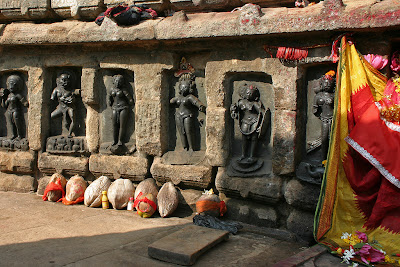Srinivasan got up, awake into his familiar world, yet the images of another world hung vividly in his mind as he didn't make any sense of the place he had just seen in his dream and yet, it was so familiar. It was close to reality, some place he had been to and had felt something drawing him so close, saving him from something he had no idea about yet felt its overpowering presence in his life.
 View location of this temple - Photographed in 1911
View location of this temple - Photographed in 1911 He walked on, coming up to a formidable wall. A wall that didn't seem to have anything around, and nothing beyond. It stood deserted lost in a realm of its own, yet an endless flight of steps seemed to lead to the skies above with a hint of stone beyond, ancient stone that belonged to another era unknown, just withered by time and belief. Srinivasan stood and gazed beyond as the bells ringing reverberated through the air. The chilling air settled in his mind as he stared up to ascend the steps to heaven. Srinivasan felt strange, not knowing what to expect. He just felt blank as he decided to see what really lay beyond. Every step up reminded Srinivasan that he had been here. The lanscape, the emptiness, the strange architecture that contradicted every book and every proven theory of art...nothing seemed to have value except this moment as he took to the steps. He touched the bell and rang it, the brass resonating the sound echoing within itself rang through his mind and senses. There was strange peace within his mind. He walked up, crossing this strange wall that housed a narrow door but led to no roof beyond but just a mammoth temple, made of ancient rock, octagonal in shape rising into the sky.
He walked on, coming up to a formidable wall. A wall that didn't seem to have anything around, and nothing beyond. It stood deserted lost in a realm of its own, yet an endless flight of steps seemed to lead to the skies above with a hint of stone beyond, ancient stone that belonged to another era unknown, just withered by time and belief. Srinivasan stood and gazed beyond as the bells ringing reverberated through the air. The chilling air settled in his mind as he stared up to ascend the steps to heaven. Srinivasan felt strange, not knowing what to expect. He just felt blank as he decided to see what really lay beyond. Every step up reminded Srinivasan that he had been here. The lanscape, the emptiness, the strange architecture that contradicted every book and every proven theory of art...nothing seemed to have value except this moment as he took to the steps. He touched the bell and rang it, the brass resonating the sound echoing within itself rang through his mind and senses. There was strange peace within his mind. He walked up, crossing this strange wall that housed a narrow door but led to no roof beyond but just a mammoth temple, made of ancient rock, octagonal in shape rising into the sky.A narrow door lay ahead holding secrets within its darkness. The main door appeared strangely similar to that he had seen within the pyramids of the Maya. Yet this kind of architecture was unknown and untapped back here. Srinivasan walked up to the main door, and looked at the world now at his feet. He was told it was the temple of Adi Shankaracharya, an ancient Shiva temple, that came to be known by this great saint's name centuries ago when he visited it and worshipped the Lord here. Adi Shankaracharya was known to have been initiated into the Shakti cult during this period.
Srinivasan entered the narrow entrance and walked through its thick walls. What lay ahead of him was a breath taking view of the Lord. A stone linga towered in front of him, topped with floral offerings. A small chamber held more than just air and stone. Srinivasan came down on his knees, overwhelmed with the presence of the Lord in front of him. It was not just another temple, it was the world of Shankaracharya relived, the world of Lord Shiva brought alive again within his mind, the world of Shankaracharya temple waking up another soul to itself, far away and above the familiar world, one that promised experiences beyond the realm of the self, soaking the soul in the air within these chilling ancient walls experiencing the meaning of perfect life.
Courtesy:
Takhat-e-Sulaiman / Shankaracharya Temple. Srinagar 1911
sgankaracharaya - KPLink.com photo gallery
© 2003 shankracharya.com. All rights reserved.
















